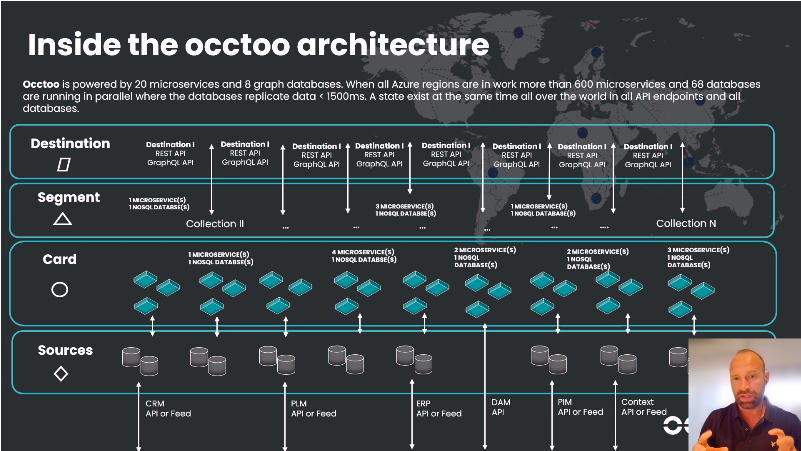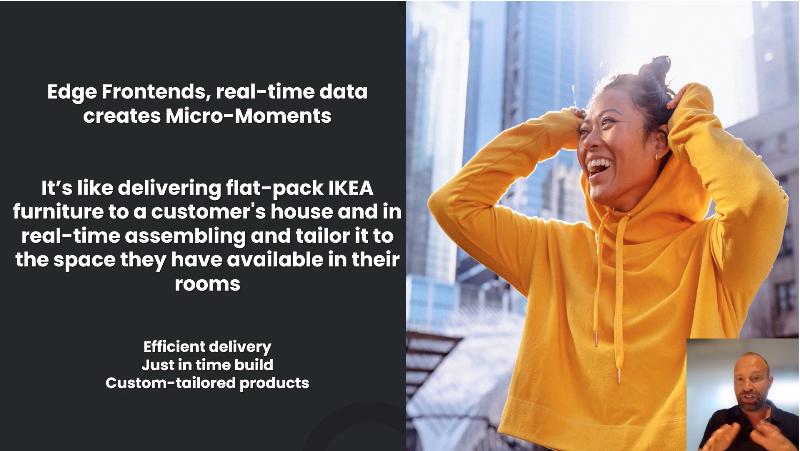Would you prefer to watch my product video instead of reading this blog? Scroll to the bottom of this page to watch in full.
Moving data into an 'Experience state' is going to be increasingly essential as we move towards a new state where the number of frontends will explode.
To excel in your frontend experiences, you must be able to easily add and combine new data fields or content attributes, and share this via real-time APIs, not be restrained by a last silo-approached frontend database built in old technology.
See Occtoo documentation here
Turning your Enterprise data into Experience data - what do I mean?
Your organization likely handles tons of data across various systems: your product managers working in the PIM/PLM area, your distributors updating shipping information in the WMS or OMS, and your marketing and sales team in the CRM - This data is in an Enterprise state. This way of storing data slows the data down and using the data outside the core application is harder and it is not scaled for servicing external requests when building customer-facing applications.
In the Experience state, the data is fast, and easy to unify, segment, filter, and distribute using simple tools that your digital team has access to at their fingertips. You should be able to create application-specific data endpoints only containing the data needed in a matter of minutes and not days or weeks, WITHOUT lengthy integrations!
To turn Enterprise data into Experience data it must be stripped down into its simplest form, making it free from its old data model (data shape); in Occtoo this is a simple key-value format (Occtoo Source).
Occtoo removes the existing structure from your data and pushes it from its original source through Occtoo. It then rebuilds that purpose and that structure in order to make it available fast and repurpose it for the different needs and different frontends. Occtoo is a Digital Experience Composition.
Occtoo's purpose is to on-board and expose the data in new APIs: moving it from enterprise state to experience state.
Inside the Occtoo architecture
Let's take a look inside the Occtoo Architecture to understand where your data goes in and how this fuels frontend experiences with relevant, real-time data.

Occtoo Source (Where is the data I need?)
The process of on-boarding data is handled by the Occtoo Source. This blok makes sure the data from your individual systems is on-boarded and accessible across different data domains. To assist you in on-boarding data through the Source Blok, Occtoo provides a set of open-source tools and code examples.
Occtoo Card - What attributes from my source do I need and what do I need to combine?
To make the data more intelligent (unify across data domains) you can use relations and mappings. This is achieved by using a combination of business rules, tags, faceting,. The card Blok is responsible for the mapping of the on-boarded data and, if needed, enriching it further on-boarding of any 3rd party data sources. This is where you define your on-boarded data and end up with a unified dataset that can be used to power your new digital experiences.
Occtoo SegmentTo build relevant experiences, you need to present just the right products matched with the right content to the end customers. You can do this by shaping the experience based on the customer and unifying it with their current context. For customers, we might have information such as their gender, interest, or similar information typically contained within a CRM or CDP. Context could be dependent on things such as the device, location, weather, or event: this is information we can get from the user session variables. In Occtoo, the activation of these data points is configured in the Occtoo Segment blok, this is where you define what data the experience should consist of.
Occtoo Destination - The frontend. Who, how & when is my data consumed?
Building new and fast digital experiences requires the data to be available anywhere around the world within milliseconds, pushed to various platforms in the correct format and fashion. This is the task for the Occtoo Destination blok. Occtoo can scale any data around the world when needed, giving developers access to data as though it was local for their applications. The data is geographically scaled with millisecond response times, fully documented (swagger), and ready for you to start using right away.
Edge frontends and real-time data
The main role of your system of records is to store and maintain all your single domain-specific data. The job of an Experience Data Platform (Occtoo) is to unify and activate your data, bringing it to life using real-time APIs.

You don't need to rip and replace your system of records built on legacy technology. Occtoo simply sits on top of these systems, unifying all data and transforming it into light weight and easy consumable data through real-time APIs. Your previous investments become even more valuable because the data is easier for your digital teams to actually use.
